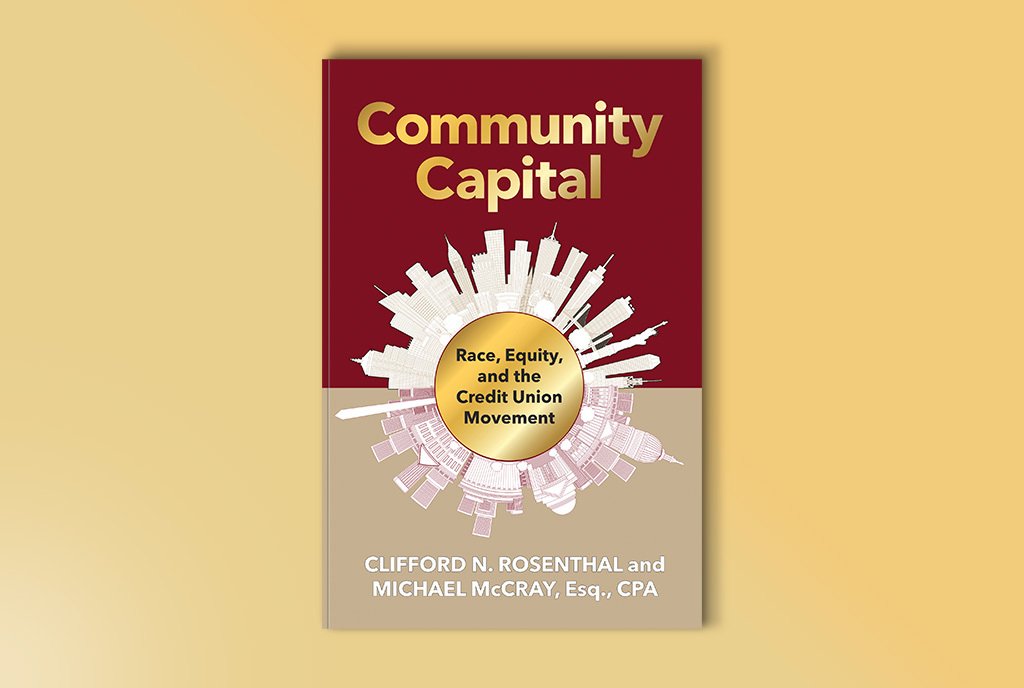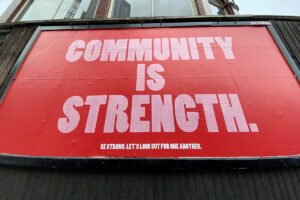
Truth to Power is a regular series of conversations with writers about the promises and pitfalls of movements for social justice. From the roots of racial capitalism to the psychic toll of poverty, from resource wars to popular uprisings, the interviews in this column focus on how to write about the myriad causes of oppression and the organized desire for a better world.
Steve Dubb: Can you each give some information about your backgrounds?
Cliff Rosenthal: I abandoned a career as a Russian historian to be a co-op organizer starting in the 1970s. In 1979, I discovered financial cooperatives—namely, credit unions—and I joined the National Federation of Community Development Credit Unions in 1980. I became its head in 1983 when everyone else left because we had lost our funding under President Reagan.
I led the organization, which is now called Inclusiv, from 1983 until 2012, when I joined the Consumer Finance Protection Bureau to set up their Office of Financial Empowerment. I did that for two years and then resumed my career as a historian and writer. Writing Democratizing Finance in 2018, and now with Michael, we published Community Capital: Race, Equity and the Credit Union Movement, which also touches on CDFIs [community development financial institutions].
Michael McCray: I was born into community development finance. My mother, Dr. Jacqueline McCray, she was the dean of agriculture and the administrator of the cooperative extension program at the University of Arkansas in Pine Bluff and created the first USDA Center of Excellence in Regulatory Science. So, I grew up in a household where community service and community development is what we talked about at the kitchen table. And I tell people that a funny thing happened on my way to Wall Street. My governor ran for president, and I got to work at the White House.
So, my bachelor’s was in economics, and my MBA is in finance, and I was planning on going to Wall Street. But when Governor Clinton ran for president, I wound up with the opportunity to do what I thought I wanted to do in corporate finance, but it became economic development. So, I was a community development specialist for a White House initiative called the Federal Empowerment Zones Program. It was actually a dream job of mine where I was able to work to redevelop communities like my hometown, but it was from a federal perspective. During that time, my dream job became a nightmare when I reported $40 million worth of waste, fraud, and abuse where essentially people were stealing from poor people.
I was just appalled that so much waste and fraud could happen in a program that was designed to help poor people. I don’t mean that in a pejorative way, but low-to-moderate-income people, working-class people. So, I decided to speak up. At the time, I didn’t really realize I was starting my journey as a whistleblower, but that’s really what happened. And then I wound up leaning into it and becoming one of the leading advocates for whistleblowers.
SD: Cliff, in the book, you write at length about how community development credit unions (CDCUs) were often treated as the “poor relations” of the national credit union movement. Why is this? And how can the credit union movement, which currently has $2.3 trillion in assets, better support its CDCU members?
CR: As you may know, the credit union movement in the United States started in the first decade of the 20th century as a working-class movement. But in the mid-20th century, as America built a bigger middle class, the credit union movement reoriented itself as well. One of their slogans was: “Middle-class people need credit unions too.”
So here we were, low-income credit unions during the 1960s as part of the war on poverty. Lots of credit unions were created that were associated with anti-poverty associations. Many failed because federal support for them was very limited and of short duration. The feds were operating under the theory that these institutions should become self-sufficient within two years, which was very far-fetched and very wrong. So, there was kind of a stigma to credit unions serving low-income communities.
“There was kind of a stigma to credit unions serving low-income communities.”Meanwhile, our regulatory agency, the National Credit Union Administration (NCUA), for much of the time I worked at the credit union federation, was under the philosophy that it would be better to have fewer but larger credit unions.
For much of the 1980s, I was engaged in a fight against the impending extinction of our type of institution. And that is what drove me to create the concept paper in 1988 for the creation of a federal fund that would invest in institutions that would serve marginalized communities and people. And that’s what I pursued, and that’s how I cofounded the CDFI movement. We joined forces with Bill Clinton, who in 1991 ran on a platform of creating 100 community banks like South Shore and the Grameen Bank and 1,000 microenterprise funds.
So, we went literally from having half a dozen of us sitting in borrowed space at Trinity Church at the foot of Wall Street theorizing about this stuff to 18 months later sitting in the Rose Garden of the White House when Bill Clinton was announcing this program to create the CDFI Fund.
SD: One little known fact about credit unions is that depositary insurance, which began for banks in 1933, did not begin for credit unions until 1970. Superficially, adding insured deposits would seem to be a boon, but clearly it also created new regulatory costs. Could you explain what those costs were?
CR: Sure, along with deposit insurance, they created the National Credit Union Share Insurance Fund, which is run by the regulator. Over the course of decades, concern for the financial solidity of the Share Insurance Fund came to basically wag the whole dog in terms of safety and soundness from a regulatory perspective.
SD: Michael, you write primarily about Kappa Alpha Psi Federal Credit Union. Can you talk about Kappa Alpha Psi and how it is that this Black fraternity came to develop a national credit union?
MM: A general audience may not understand the role Black Greek-letter organizations play in African American communities and the role of the Divine Nine. These are some of the most important social organizations in our community. They do a range of things, including economic empowerment.
The Kappa Alpha Psi Federal Credit Union was Kappa Alpha Psi’s attempt to provide banking and financial services. We were the arm that was tasked to do that. We were not the first or only one. We were the first virtual credit union that was ever chartered by NCUA. So, in that sense, we have been trendsetting and trendbreaking. We had no peers because there was no model for us. When regulators examine you, they look at your peer ratios. It was a challenge being the only low-income virtual national credit union with no comparable institutions.
SD: Could you give readers a sense of the size of the credit union in terms of membership and assets at its peak before it was shut down in 2010?
MM: We had roughly a million dollars—about $750,000 on the street. We were a tiny credit union. For me, that was the most daunting thing. For regulators to say that our financial challenges were risking the entire Share Insurance Fund was clearly absurd. We were far too small to put the fund at risk.
Mind you, we were in prompt corrective action, meaning we had revised our business plan in cooperation with the regulator to restore our net worth. Meanwhile, when the corporate credit unions with tens of billions of dollars blew up at roughly the same time, the regulators took money from all credit unions to save the larger ones. And the assessment broke our net worth restoration plan. So, you’re literally taking the milk from babies to feed the large behemoth, the one that was messed up. It was very, very frustrating.
SD: You’re talking about US Central?
CR: Yes, it was US Central and the other corporates—the state and regional corporates. Basically, the excess liquidity from the un-lent money from credit unions would channel up to state corporates and then ultimately to US Central [Federal] Credit Union, which had $30 billion-plus, a good portion of which was invested in subprime mortgages, which incurred huge paper losses that resulted in its liquidation.
SD: Why was US Central investing in subprime mortgages?
CR: The search for yield. Credit unions were born with a social mission, but increasingly, as they grew in size and sophistication, they became more bank-like in their operations and felt compelled to compete in the capitalist market, which is to say, “We’ve got to provide the highest returns for our members. Otherwise, they will go to the banks.” And how do we do that? Well, there are these securities that are out there that are offering us better yields.
They were chasing yields like most institutions do in our economy. They weren’t reinvesting.
SD: Cliff, you write in the book that the CDFI Fund, as it developed, served to support primarily White-led, unregulated community development loan funds (about 80 percent of funds). Why is that? And what is it doing now to shift that?
CR: If you see the Federal Reserve of New York study, what has happened is that there has been a huge influx of credit unions over the last four years that has tipped the balance. Loan funds no longer predominate; they are still the largest plurality but no longer an absolute majority. That’s tipped the balance quite a bit.
They were applying the rules that apply to Bank of America to a small credit union.
One of the major investment rounds of COVID funding, the Rapid Response Program, established a floor of $250,000 so that even the smallest institutions, and I’m talking about some credit unions that we had with less than $1 million, were able to get a substantial grant that on a competitive basis, they would never have been able to get. I regard that as a major advance in equity under the CDFI Fund, and I am glad to see it.
Sign up for our free newsletters
Subscribe to NPQ's newsletters to have our top stories delivered directly to your inbox.
By signing up, you agree to our privacy policy and terms of use, and to receive messages from NPQ and our partners.
SD: I think you’re saying that formula funding helps smaller CDFIs.
CR: Small institutions, not just CDFIs. And the increasing awareness. When we started the CDFI movement in the early 1990s, there was one CDFI coalition, and, in all honesty, it was mostly White guys with one or two women who joined.
Now you have seen the African American Alliance of CDFI leaders, you see the National Association of Latino Community Asset Builders (NALCAB), and so on. So, you’ve seen lots of subsectors that have been strong advocates for greater capitalization of their sectors. If you’ve read the testimony of Bill Bynum over the years, Bynum has made the point that African American CDFIs have never been as highly capitalized as their White peers.
Is it conscious racism? Probably not. But it’s basically implicit bias and disparate impact. Those institutions that had capacity, which also meant capital and so forth, were better able to apply for money from the CDFI Fund. We’ve seen some positive movement in recent years for more equitable funding because of greater advocacy.
SD: Cliff, the book’s description about how the CDFI Fund in its early days favored impact and performance rather than equity is important. Could you expand on that? What was the argument? Why did the feds go the way they did?
CR: Well, think back to the early days of the CDFI movement. Here was this unproven industry. And, in defense of the leadership of the CDFI Fund at that time, the agency was very vulnerable. Clinton was under attack by Newt Gingrich after the GOP gained control over the House and the Senate—and many statehouses as well. So, they were extremely wary about failure. And the choice that they made is “we want to choose institutions that give us the greatest chance of impact and performance.” There wasn’t enough money to go around, so they made that kind of choice. I understood the logic of their argument.
For my membership, what I was concerned with [was investing] in the neediest institutions that have been the most marginalized in rural and low-income areas.
We had everything invested in the notion that after decades of being the “poor relatives,” we would finally find a source to help build up our capital so we could compete, but that didn’t happen for many years. That’s why I was constantly in the position to advocate with the fund for policies for small institutions. It took from 1994 to 2000 to get a window for small CDFIs specifically on it.
SD: Even after 2000, the percentages did not change a lot until the 2020s. Were there multiple stages?
CR: It wasn’t dramatic. But there was a window for small amounts going to smaller institutions. They weren’t so much competing with the bigger guys. The amounts that they could get were relatively small at that time.
I think the breakthroughs have really come in the last few years. And, also, again, the shift in the makeup of the CDFI field. All of the credit unions, all these depositories that have come in, have changed their priorities to some degree. I think the CDFI Fund, for most of their existence, said, “Well, the majority of these are loan funds, so that substantiates the case that the majority of funding should go to loan funds.”
None of this was irrational. But implicitly, those with capacity got rewarded. And where does capacity lie? The CDFI Fund, in the end, was a sophisticated competitive grant-writing competition. And those who had less capacity were less well-equipped to get a fair share.
MM: The bias even goes into that argument. Because I was a grant writer. I would write grants based on our capacity to deliver services nationally. Kappa Alpha Psi fraternity is large, with 120,000 members, but [the] Kappa Alpha Psi credit union was small. I received early rejections. I came to realize that the regulators did not believe that we had the capacity to deliver the services that we planned.
Things that we were talking about for decades are now coming out of the mouths of our regulators.The final year, I wrote the grant from the perspective of “let me explain to you Kappa Alpha Psi fraternity.” And so, I wrote it from that perspective, then at the end of it, I wrote, “We have a credit union to use this backbone infrastructure to deliver services that would qualify for the grant.” That grant would have won [if] they hadn’t liquidated us. It was for $100,000. They literally marked out in black the award after we had been liquidated. Had we gotten that grant, it literally would have allowed our net worth to reach 16 to 17 percent.
SD: Michael, much of your account is kind of, to use your phrase, an Alice in Wonderland story of how small errors by the credit union were magnified and even manipulated by federal regulators to shutter the credit union’s virtual doors. At a high level, could you discuss what you see as the main steps in this process, how the shutdown happened, and why?
MM: What was going on was they were applying the rules that apply to Bank of America to a small credit union. The biggest thing is the choice of accounting rule. For larger credit unions, you have to use GAAP [generally accepted accounting principles], an accrual-based accounting system. For small credit unions, you’re on a cash basis. But the regulators insisted our small credit union use accrual accounting.In terms of your bookkeeping, it is a lot easier to keep up with debits and credits if when I spend money, I record it. That’s how cash basis works. As opposed to, “Is this an expense that we are going to divide by 360 days or 365 days?”
We didn’t have enough money to hire full-time staff. The board was doing all the work. If we had been able to hire just a manager, a lot of problems that we had would have gone away, which we shouldn’t have had to do, given that we only had five years of operations and less than $1 million in assets. We were literally being compared with institutions that had $10 million in assets or more.
SD: What lessons do you take from the Kappa Alpha Psi credit union experience?
MM: I think the jewel that is in the book is we have the NCUA closed-door transcript, where we go inside the ex parte deliberations where they decided to liquidate our credit union. Literally, it was based on a lie. But we had no opportunity to refute it.
It is an important cautionary tale for anyone who wants to fight for justice in the community development finance sector.
SD: What was the lie?
MM: During the board deliberations, some of the board members were hesitant. There was a write-up on our accounting. But some of the board members said, “This is a credit union that should have been operating on cash basis. Are you sure we want to liquidate them?”
The examiners came back and said that the credit union is being fast and loose. They alleged that we flew people in to attend an NBA All-Star weekend event. Once the board members heard that, internal opposition to shutting down our credit union disappeared.
The problem is that the examiners had brought this matter to our attention before. Our credit committee had done an investigation. It was a coincidence that the NBA All-Star weekend occurred when there was a regional conference for the fraternity. We didn’t fly in anybody for NBA All-Star weekend. They were already in Dallas.
Victor Russell, the president, took some of the board members out for drinks. It was a $94 bar charge that was repaid. The examiners knew all of that and did not tell the board members. They told them [instead that] people were flown in for an NBA weekend. When you read the transcript, you see that was the argument that tipped the tide.
We literally got liquidated on a lie.
SD: Cliff, you indicate in one of the last chapters of the book that the federal response to COVID led to considerably enhanced federal support for community development credit unions—both in funding levels and, at least to some extent, in policy and cultural change. What are these changes?
CR: In the last few years, there’s been a real sea change beyond what I could’ve imagined. What we have seen are massive infusions of federal funds under the IRA and so forth, but also extraordinary change in the regulatory agency. The things that we were talking about for decades are now coming out of the mouths of our regulators. So, for example, for years—and this relates very much to Kappa Alpha Psi—they did not have a peer group that they were being compared to.
Now, literally, the regulatory agencies say, “Examiners, you’ve got to understand that minority depositories and community development credit unions are a special breed, and you should be comparing them to each other.” These were the changes that we fought for—for years, for decades—and finally, we are beginning to see them now. In short, in the current environment, Kappa Alpha Psi credit union would never have been liquidated. No chance. The regulators would have found every way to help this credit union develop and grow.











